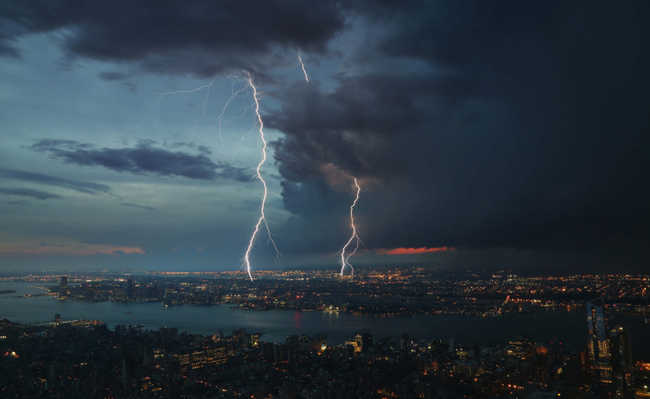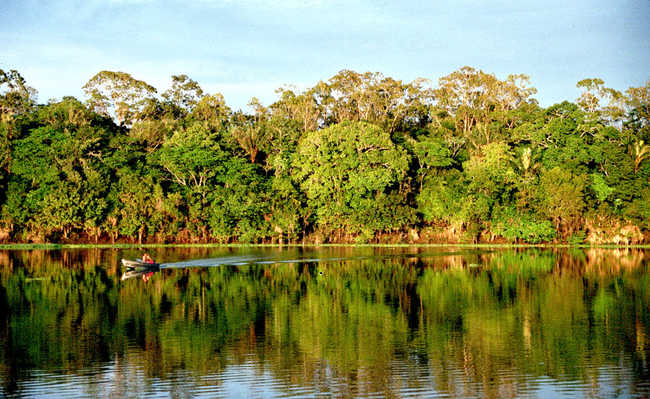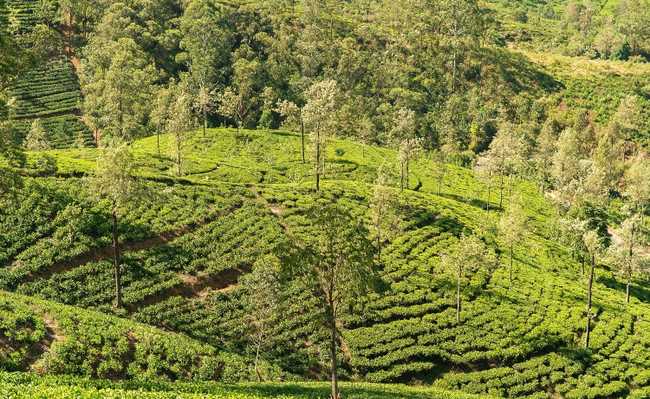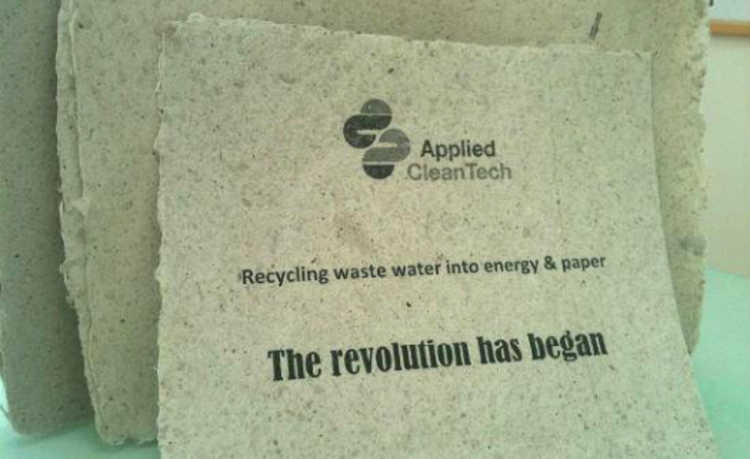What is global warming?
Global warming is the increase in the global average temperature in the atmosphere and oceans

Resized image by Ian Froome, is available on Unsplash
Global warming is the process of changing the global average temperature of the atmosphere and oceans. The accumulation of high concentrations of greenhouse gases in the atmosphere blocks the heat emitted by the sun and traps it on the Earth's surface, increasing the Earth's average temperature.
- What is the greenhouse effect?
The world is getting warmer. But is this a natural process on Earth or is it human action? There is a lot of discussion around the subject, but it is always good to clarify what global warming is, a process that the video produced by the team from eCycle portal explains:
Despite contributing to global warming, the greenhouse effect is a fundamental process for life on Earth, as it makes the planet stay at habitable temperatures. But the significant increase in greenhouse gas emissions associated with natural phenomena and actions promoted by human activity, such as the deforestation of forests, have been determining factors in the imbalance in the system's energy balance, causing greater energy retention and an increase in the effect. greenhouse, with the warming of the lower atmosphere and an increase in the planet's average temperature. Global warming has become one of the Earth's biggest problems, with effects that can be catastrophic, including direct health effects.
Thus, global warming is a process that results from the intensification of the greenhouse effect - the radiation that comes from sunlight reaches the Earth and is absorbed by gases present in the atmosphere, which start to emit infrared radiation back to the Earth's surface ( heat), increasing the temperature of the planet. Gases that interact with solar radiation to produce infrared radiation are called Greenhouse Gases or GHG. To learn more about this topic, check out the article: "What are greenhouse gases".
Understand better what the greenhouse effect is in the article on the topic and in the video, produced in partnership between the Brazilian Space Agency and the National Institute for Space Research:
some places will get colder
Despite the name "global warming", this phenomenon, the main cause of climate change, is responsible for generating episodes of extreme cold in some regions. This confuses a lot of people. Including President Donald Trump, who thought that the low temperatures in the United States in 2019 were proof that global warming does not exist. The fact is that no single event like the one in the US can prove or disprove the global warming thesis. At global levels, it is only possible to make hypotheses when analyzing the Earth's history in geological time, which is very long.
The increase in the emission of greenhouse gases increases energy retention in the oceans and atmosphere, causing an increase in the intensity, frequency and impact of extreme weather events, whether cold or hot.
A phenomenon that undergoes changes with global warming is thermohaline circulation. These ocean currents, driven by density differences caused by the presence of salt, are responsible for carrying heat to certain regions. With global warming and the melting of the polar ice caps, the concentration of salt decreases, which can stop or slow down the thermohaline circulation.
The deceleration of thermohaline circulation caused by global warming may explain the decrease in temperature in certain regions. Although overall global temperatures increase, the absence of warm currents in naturally occurring regions will result in lower temperatures.
That doesn't mean luck. In a darker setting, a drastic reduction in thermohaline circulation can cause temperatures to drop considerably. If the slowdown continues, Europe and other regions that rely on thermohaline circulation to keep the climate reasonably warm and mild can look forward to an ice age. Learn more about this topic in the article: "What is thermoaline circulation".
Studies
If human action is not the only cause of global warming, its impact is considerable. Although there is no consensus on the causes of global warming, most of the scientific class recognizes human activity as its main trigger.
A study by the University of Bristol, UK, and published in the journal nature, estimated that an increase in sea level could be in the order of 90 centimeters by the year 2100. This, according to the study, would be due to the melting of glaciers and the expansion of ocean waters, caused by the increase in global temperature . The rise in sea level would cause the disappearance of islands and even entire countries, in addition to damage to coastal cities, caused by the disappearance of lower areas.
Another study suggests that global warming could increase the number of volcanic eruptions. By analyzing the last million years, researchers were able to establish a direct relationship between global warming and the increase in volcanic activity. This is because, with the increase in the amount of water in the oceans caused by the melt, the pressure on the sea floor increases, making the chances of eruptions increase.
Research led by Nigel Arnell, director of the Walker Institute, University of Reading, UK, shows that establishing policies that guarantee a temperature rise of up to 2°C by the year 2100 can reduce 65% of impacts environmental issues. The prediction is that by the end of the century, global warming will drive the planet to a temperature up to 4°C warmer. The Paris Agreement, established in December 2015, has the goal of limiting global warming to 2°C by 2100.
In a report commissioned by the World Economic Forum, entitled Global Risks 2013, global warming associated with the imbalance of the greenhouse effect was already recognized as the third biggest global risk due to the great climatic phenomena of 2012, such as Hurricane Sandy and the floods in China. The insurance industry is a good example of this - it follows with apprehension the growing succession of natural disasters that directly and unpredictably impact the risk of its operations.
Consequences for the population's health
Climate change resulting from global warming increases the intensity, frequency and impact of extreme weather events, whether cold or hot. These events, in addition to impacting the environment, which includes fauna, flora, atmosphere, ocean, geochemical and geophysical environment; they cause harmful effects to human health, such as increased risk of suicide, respiratory problems, cardiovascular problems, asthma, cancer, obesity, heat stroke, infertility, nutritional deficiency, among others. These problems are even more intense in poorer populations, as a result of another phenomenon called "climate gentrification". Understand these themes in more depth in the articles: "Ten health consequences of global warming" and "What is climate gentrification?"
What to do to help reduce global warming
Awareness and attitude changes are very important when it comes to global warming and climate change. To contribute to reducing the emission of greenhouse gases, first of all, it is necessary to know where these gases are.
Reduce car usage
Carbon dioxide, one of the main greenhouse gases, is found mainly in the burning of fossil fuels such as gasoline, diesel and coal. To avoid this type of pollution, reducing deliberate car use is a good way to go!
How about using a bicycle, public or collective transport?

Tiffany Nutt image on Unsplash
Bicycles are good options for short and long distance trips. Carpooling and quality public transport, especially trains and subways - which use renewable energy sources - are great alternatives. When the place is very close, walking is also a good way out.
be vegan

Image: Anna Pelzer on Unsplash
The massive use of nitrogen fertilizers in agriculture for livestock feed is also a strong amplifier of global warming, since in addition to requiring large amounts of energy in their production, when applied to the soil, they release nitrogen into the atmosphere. The gas, combined with oxygen, gives rise to nitrous oxide (N2O), a powerful GHG, whose potential for retaining heat in the atmosphere is 300 times greater than that of carbon dioxide (CO2).
Methane, on the other hand, GHG about 20 times more powerful than carbon dioxide in retaining heat in the atmosphere, comes to it in different ways: emanation via mud volcanoes and geological faults, decomposition of organic waste, natural sources (ex: swamps ), in the extraction of mineral fuel (such as shale gas via hydraulic fracturing extracted from black shale), enteric fermentation of animals (herbivores, carnivores and omnivores), bacteria and heating or combustion of anaerobic biomass.
Agriculture is strongly an activity that amplifies global warming; this is because in the process significant amounts of GHG are emitted. A study by the University of Leeds, UK, showed that reducing red meat consumption is more effective against greenhouse gases than not using a car. According to another survey by Oxford University, if everyone were vegan, eight million deaths a year would be prevented and pollution would decrease by two-thirds. Learn more about veganism in the article: "Vegan philosophy: know and ask your questions".
Composting is good!

Julietta Watson image on Unsplash
Regarding the decomposition of organic waste, biodigestion and composting are considered mitigating technologies for reducing GHG emissions per ton of treated waste; the first has the advantage of generating energy as a by-product and the second, natural fertilizer. To understand more about these themes, check out the articles: "What is composting and how to do it" and "Biodigestion: recycling organic waste".
The fewer CFCs the better
Although the consumption of CFCs (chlorofluorocarbons) has been eliminated in the country in a regulatory manner, refrigeration and air-conditioning equipment that operate on the basis of these harmful gases are still in operation. As an alternative to CFCs, under the argument of being 50% less destructive to the ozone layer, HCFCs (hydrochlorofluorocarbons) emerged. On the other hand, the new solution, based on so-called fluorinated gases, represents a great contribution to global warming. That's because this alternative technology can be thousands of times more harmful than carbon dioxide, which has led the European Union to push for its ban in favor of non-synthetic natural alternatives, such as ammonia or carbon dioxide itself, which have high cooling properties.
Finally, there are still important actions to be taken that concern the political character of our life in society. A conscious and environmentally educated citizen brings together the arguments and the necessary conditions to, in addition to making the best choices in relation to consumption, pressurize governments, companies and representatives of society to take more viable socio-environmental decisions and postures and, consequently, combat global warming . Examples of these actions are the ability to articulate in society, support representatives who show concern with urban mobility, global warming and all other issues related to sustainability.










